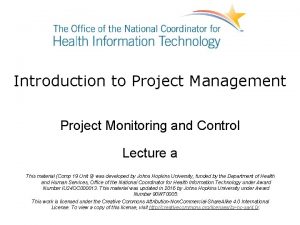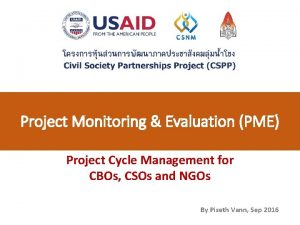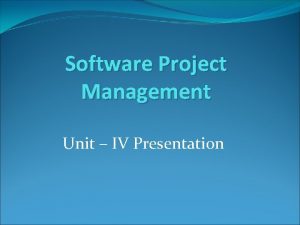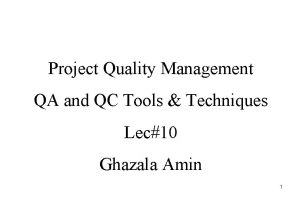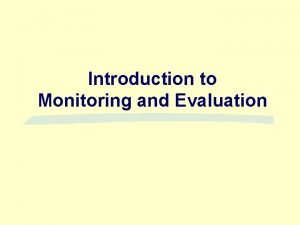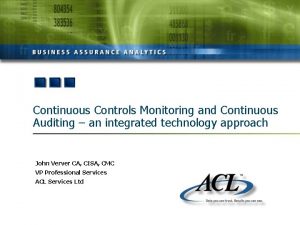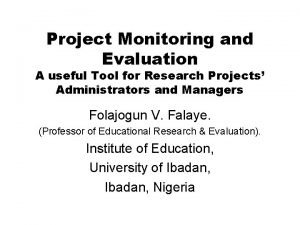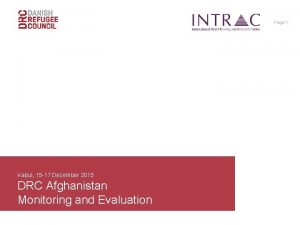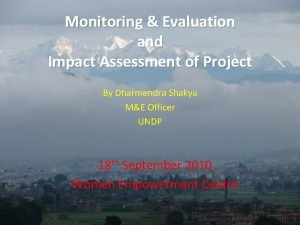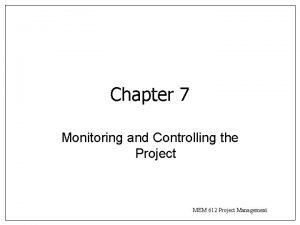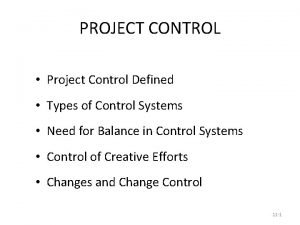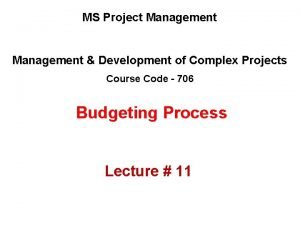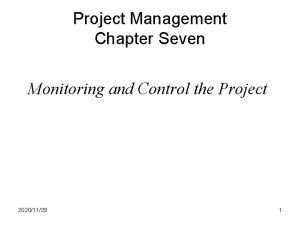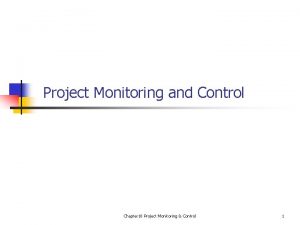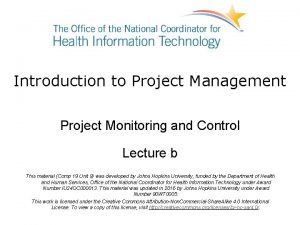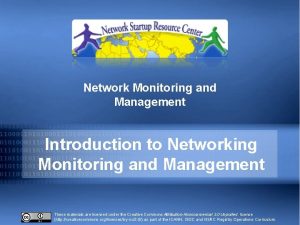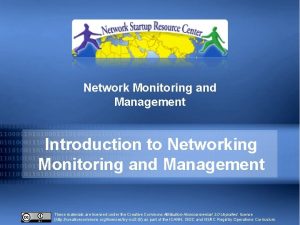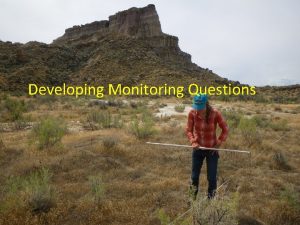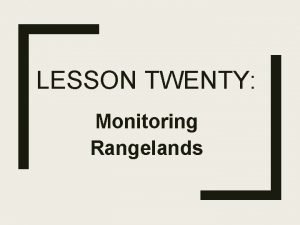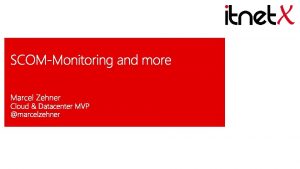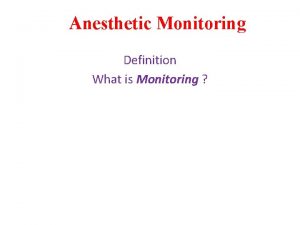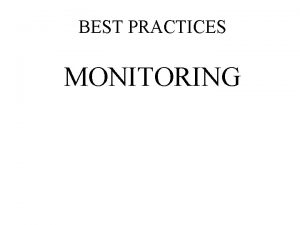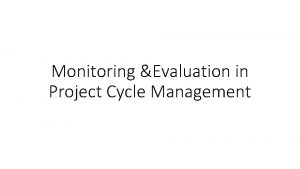Introduction to Project Management Project Monitoring and Control

















- Slides: 17

Introduction to Project Management Project Monitoring and Control Lecture a This material (Comp 19 Unit 9) was developed by Johns Hopkins University, funded by the Department of Health and Human Services, Office of the National Coordinator for Health Information Technology under Award Number IU 24 OC 000013. This material was updated in 2016 by Johns Hopkins University under Award Number 90 WT 0005. This work is licensed under the Creative Commons Attribution-Non. Commercial-Share. Alike 4. 0 International License. To view a copy of this license, visit http: //creativecommons. org/licenses/by-nc-sa/4. 0/.

Project Monitoring and Control: Learning Objectives — Lecture a • Direct project execution. • Track, review, and report project progress and performance. • Monitor and control project baselines. • Manage stakeholder expectations and change requests. 2

Where Does Monitoring and Control (M&C) Fit in Project Management? 9. 01 Figure. Courtesy of Theron Feist. 3

Monitoring and Controlling Processes 9. 02 Table. Courtesy of Johns Hopkins School of Nursing Staff. 4

Monitor and Control Project Work • Performance objectives are detailed in the project management plan. • Project manager: – Tracks, reviews, and regulates the progress of the project. – Produces reports with project performance information regarding the scope, cost, resource, quality, risk, and schedule. 5

Managing Project Constraints 9. 03 Figure. Creative Commons, John M. Kennedy T. 6

Establishing Project Baselines • Baselines: documented values used for future comparisons. • Key baselines: – Scope: tasks and work packages in work breakdown structure. – Time: planned start and end times for all work packages. – Cost: estimated cost for each work package. 7

Manage Baselines with Earned Value Management (EVM) • EVM is a technique for monitoring and controlling your scope, time, and cost baselines. • EVM uses, for each work package: – Planned values for cost and start/end times. – Actual costs. – Estimate of how much work was completed. • With EVM, you can calculate variances that show you if your project is on track. 8

Progress Reporting • Provide mechanisms for the team to review project performance—meetings or online posting of information – Have team members report on status of all current and planned tasks – Review risk management plan and risk response activities • Compare actual performance against plans: – Schedule: Planned vs. actual completion times of tasks and deliverables – Costs: Budgeted costs vs. actual costs 9

Track Progress with Gantt Chart 9. 04 Figure. Courtesy of Johns Hopkins School of Nursing Staff. 10

Why Is it Important to Manage Scope? • Failure to manage scope is a leading cause of project failure. • Project scope can “creep” or expand during a project—often without notice. • Your project team is doing more than was planned—without additional resources! • Defining the scope—and sticking to it during the project is not as simple as it sounds. 11

Tips to Control Project Scope • To control scope and counter scope creep, ensure that your project team: – Knows project scope. – Understands the importance of detecting activities, events, or statements that violate project scope, and informing the project manager for immediate attention. 12

Manage Scope: Track Requirements Satisfaction • Satisfying requirements is critical to project success! • A requirements traceability tool can help to keep track of requirements and their satisfaction in the resulting system. • Links requirements in both directions: – Backward: what was the origin of this requirement? – Forward: what part of the design and system implements this requirement? 13

Project Monitoring and Control Summary — Lecture a • Project monitoring and controlling interacts with the each phase of the project: – Project manager: controls scope, schedule, and budget. – Baselines. – EVM. – Manage stakeholder expectations and change requests. 14

Project Monitoring and Control References — Lecture a — 1 References Bennatan, E. M. On Time Within Budget: Software Project Management Practices and Techniques, 3 rd Edition. New York: John Wiley & Sons; 2000. Fleming, Q. W. , and Koppelman, J. M. Earned Value Project Management, 3 rd Edition, Newtown Square, PA: PMI; 2006 Health Information and Management System Society. Chicago, IL. 2010. Available from: www. himss. org Houston S, Bove LA. Project management for healthcare informatics. Springer Science + Business Media, LLC; 2010. Kerzner H. Project management: a systems approach to planning, scheduling, and controlling. 10 th ed. Wiley; 2009 Nicholas, J. M. , and Steyn, H. Project Management for Business, Engineering, and Technology, 4 th Edition, Oxford, UK: Butterworth-Heinemann, 2011. A Guide to the Project Management Body of Knowledge: (pmbok Guide). 5 th ed. Newtown Square, Pa. : Project Management Institute, 2013 Project Management Institute, Practice Standard for Earned Value Management. 2 nd ed. Newtown Square, PA: PMI; 2011. Schwalbe K. Information technology project management. 8 th ed. ; Cambridge, MA: Course Technology; 2015. Venkataraman, R. R. , and Pinto, J. K. Cost and Value Management. New York: John Wiley & Sons; 2011. 15

Project Monitoring and Control References — Lecture a — 2 Tables and Figures 9. 01 Figure. Monitoring and Control in Project Management. Courtesy of Johns Hopkins School of Nursing Staff. 9. 02 Table. Knowledge Areas and M&C Processes. Courtesy of Johns Hopkins School of Nursing Staff. 9. 03 Figure. Scope-Cost-Schedule. Creative Commons, John M. Kennedy T. Available from: http: //en. wikipedia. org/wiki/File: The_triad_constraints. jpg 9. 04 Figure. Track Progress with a Gantt Chart. Courtesy of Johns Hopkins School of Nursing Staff. 16

Introduction to Project Management Project Monitoring and Control Lecture a This material (Comp 19 Unit 9) was developed by Johns Hopkins University, funded by the Department of Health and Human Services, Office of the National Coordinator for Health Information Technology under Award Number IU 24 OC 000013. This material was updated in 2016 by Johns Hopkins University under Award Number 90 WT 0005. 17
 Project monitoring and control techniques
Project monitoring and control techniques Project cycle management ngo
Project cycle management ngo Slip chart in spm
Slip chart in spm Traditional vs modern project management
Traditional vs modern project management Qcc tools and techniques
Qcc tools and techniques Introduction to monitoring and evaluation
Introduction to monitoring and evaluation Continuous control monitoring
Continuous control monitoring Continuous control monitoring
Continuous control monitoring Control loop performance monitoring
Control loop performance monitoring Difference between supervision monitoring and evaluation
Difference between supervision monitoring and evaluation Example of monitoring and evaluation in project proposal
Example of monitoring and evaluation in project proposal What is monitoring
What is monitoring Plan monitor control cycle
Plan monitor control cycle Cybernetic control project management
Cybernetic control project management Control accounts project management
Control accounts project management Information technology project management 8th edition
Information technology project management 8th edition Project management quality control
Project management quality control Go no go control project management
Go no go control project management
